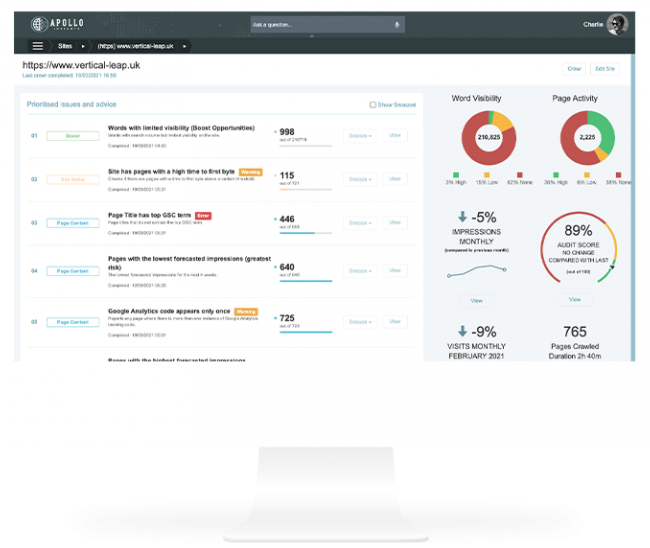Search data is siloed and inaccessible outside of the SEO team in too many businesses, limiting its reach, impact, and ability to support company success.
It’s time to rethink how we use search data.
In this article, you’ll learn three practical ways any organization can remove the shackles from their search marketing data sets and steer company critical decision making in a more meaningful, evidence-led way.
1. Formulating a Clearer, More Comprehensive Picture
Data often sits within silos (SEO, PPC, social media, direct, etc.) or inside disparate data sources such as Google Analytics, Google Ads, SEMRush, Moz, aHrefs, Majestic, or Open Site Explorer.
The list of options for marketing and business analysts is endless.
The first stage in making your data picture clearer is to remove the barriers from integrating your business information sources, creating a more expansive and meaningful data ecosystem.
There are many ways to achieve a more complete and clearer data picture for your business and the opportunities tend to fall into two areas:
- In-house technical development and data science resource capable of bringing together, processing, optimizing, refining, granting access to and insights from a wealth of data gathering remits.
- Outsourcing this requirement, most likely to a marketing/insights agency.
There will be a myriad of logic behind the option (or hybrid variation of the options) you progress, but either way, a key outcome should be this:
Easy and prescriptive access to a more complete data ecosystem that provides meaningful, evidence-led insights for making more impactful decisions throughout every critical business function.
Effective data centralization is key and lays the foundation for everything else that follows.
From data processing and integrity right through to end-users, actionable data insights, and so much more (including automation).
In my role, I work with Apollo Insights as a prescriptive data and marketing platform.

Regardless of which solution you opt for, it’s important to consider the core required outcomes such as:
- Ability to scale up actions from data.
- Quicken data-led decision-making.
- Process automation.
- Data simplification and access.
- Broader (more complete) data picture (depth, accuracy, and scale).
- Trends, analysis, and performance forecasting.
- Prescriptive action taking from existing, new, and changing data sets.
From larger useful data sets, many positive business outcomes can follow.
2. Unbiased, Real-time Decision-making
The goal of evidence-led decision-making is often as much about finding out something you didn’t know as it is about reinforcing and verifying that the judgment calls you are making are the right ones at this time.
All too often, people seek verification from data but forget to take open-minded looks into what the data is telling them.
This is a big oversight.
As a commercially viable business operating in any competitive space, you need to understand your audience and their changing behaviors, wants, needs, and pain points.
You also need to understand how the opportunities are changing (in many cases, on a weekly basis).
Being the first to act can provide many competitive advantages. The ability to pivot, change focus, and take action sooner all sit within your existing data.
3. Intelligent Automation
I would estimate that intelligent automation (IA) through areas such as robotic process automation (RPA) can alleviate the unnecessary manual labor on repetitive tasks from anywhere upwards of 70-80% of a marketer, analyst, and related field specialism within the workplace.
Robotic Process Automation is the technology that allows anyone today to configure computer software, or a “robot” to emulate and integrate the actions of a human interacting within digital systems to execute a business process.
Source: UiPath, April 2021.
The purpose of IA and RPA especially is not to remove people from key roles, but to maximize their value in ways that require their level of expertise and specialism.
This is achieved by:
- Removing and reducing process-led activities that are frequently repeated, which in most cases are more suited to a computer program than a human being.
- And empowering them to spend a majority of their time using the data rather than recombining and mining the data in the first place.
Marketing is a perfect example of this in action. A typical marketing expert uses anywhere from 20 to 50 separate analytics packages, crawling software, insights tools, and office packages to get to a stage where the experiential and specialist work can even begin.
Adding to this, the marketing/data/analyst is also expected to already know what they are looking for. They are expected to at least have a clear hypothesis to test.
And this is before they even know the right data sources, manual recombination, and research work to undertake before they can start to action meaningful activity.
Just thinking about this process is tiresome, stressful, and demotivating. Imagine this being replicated throughout every member of your team and throughout the company, plus the associated inefficiencies, time delays, and missed opportunities this equates to.
Intelligent automation can take many forms. In fact, you will be doing some of this by having a proactive team who simply want to achieve more value in less time, and spend more of their time implementing insights rather than sourcing them.
Even so, you will want to:
- Steer this journey.
- Prioritize where automation in an intelligent way can have the greatest business, commercial, and cultural benefits.
- Centralize control, manage outputs, and keep the momentum going for the long term.
Where you begin with IA will depend on your business objectives and current state of play.
However, typically I would expect this to include:
- Repeated tasks that are better suited to computers/robots.
- Time-saving automation that enables you to scale up.
- Business-critical insights that put you at a competitive disadvantage if you fail to act soon enough.
- Immediate audience understanding to position your brand at the forefront of the information/education and evaluation process in your niche.
- Unnecessary administration.
- Trends (repeat/seasonal/new/topical).
- New product and service opportunities.
What’s Next?
The purpose of this post was to enable you to see the value in your search data and to expand the use, depth, and application of this data for meaningful business impact.
I hope that the three items provided have initiated a thought process that will lead to direct action taking – whether this is auditing, assessment, or entirely new ways of working.
At this stage, the only thing that matters is taking a useful next step.
More Resources:
- An Introduction to Artificial Intelligence in Marketing
- Data Visualization: What It Is, Why It’s Important & How to Use It for SEO
- Advanced Technical SEO: A Complete Guide
Image Credits
Screenshot taken by author, April 2021





![AI Overviews: We Reverse-Engineered Them So You Don't Have To [+ What You Need To Do Next]](https://www.searchenginejournal.com/wp-content/uploads/2025/04/sidebar1x-455.png)